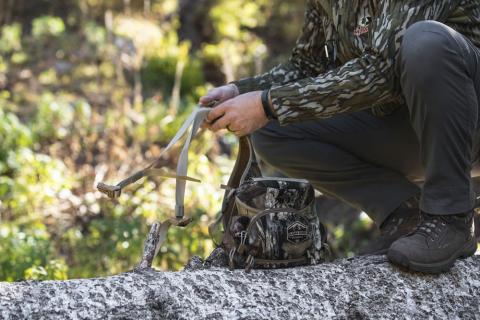provided by John E. Phillips
How fishermen make decisions on the water is the most critical ingredient in being able to catch bass on any lake they fish or that you may fish. Weather and water conditions, fishing pressure and bass movement patterns all play a role in where you’ll find bass. To be the best angler you can be, you have to do your research and mentally come up with a game plan on how you’ll fish, what lures you’ll use, and where you think the bass will be on the day you fish. In a Major League Fishing tournament that finished up on March 23, 2021, at Sam Rayburn Reservoir in Jasper, Texas, Mossy Oak Fishing Team Member Ott DeFoe of Blaine, Tennessee, won first place and $100,000. DeFoe started fishing professionally in 2006, and in 2019 he won the Bassmasters Classic. His total tournament winnings are $2,384,489, not including sponsor endorsements.
How to Fish Before a Tournament
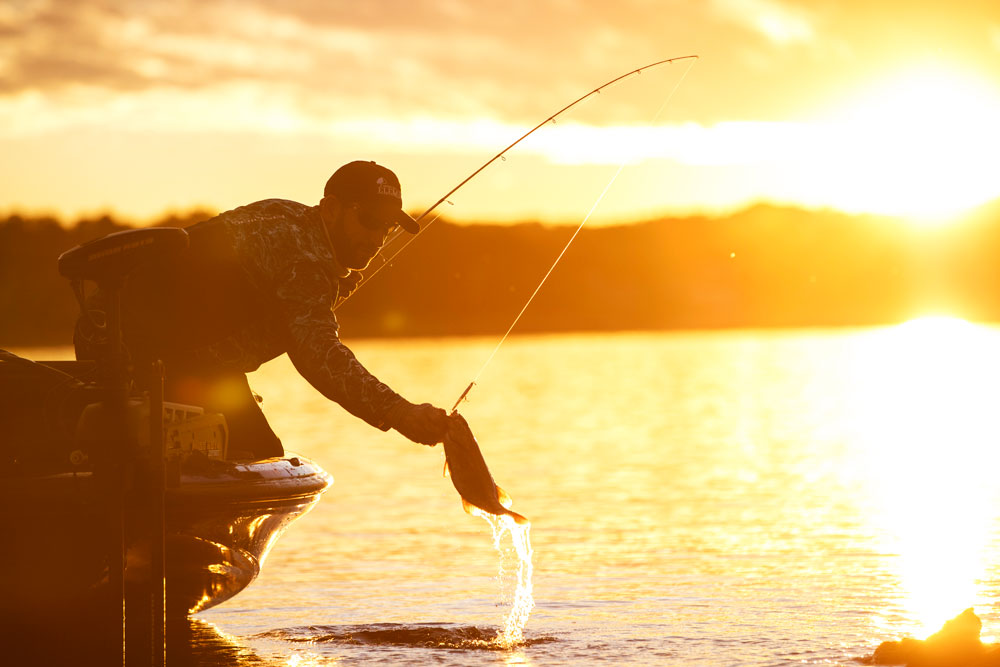
I’d only fished Sam Rayburn one time before for a tournament. I might have visited the lake a couple of other times, but still my knowledge of the lake was very limited. I’d read a lot about the lake online and studied tournament results online. Generally, I spend about 24 hours researching each lake I fish, and especially the lakes about which I have limited knowledge. On this particular lake, I spent more time researching than I would most of the lakes I fish. The main thing I looked for first were water levels on the lake. In other words, what a high level was for the lake, what was a low level, and what level seemed best to fish for bass. I looked at former tournament results, because I wanted to get an idea of what lures and what areas of the lake seemed to produce the winning bags of bass. Next, I studied satellite imagery of the lake.
From that research, I learned that the north end of Sam Rayburn Reservoir seemed to get the least amount of fishing pressure. It wasn’t the section of the lake where most five-fish limits that had won were caught. On the MLF tour, though, we wouldn’t weigh in five fish. Every bass we caught that weighed 2 pounds or more would go into our total poundage of bass caught that day. I also learned that the north end of the lake was much shallower than the south end, the water in the north section was often off-color, and there was a lot of cover in the upper end of the lake. I felt fairly comfortable about primarily fishing the north end of the lake because of the factors impacting fishing I’d learned about online.
The next part of my research was looking at the weather forecast on the days we would be fishing. In February, the lake had a bunch of ice and cold weather. After the cold and ice moved off the lake, a warm front had moved in, and no major cold snaps had occurred since those February ice storms. I also found out that the week before the tournament, the air temperature had been between 70-80 degrees, and the temperatures at night weren’t very low. As I continued to watch the weather, I learned that one or two days before the tournament was supposed to start that the lake had experienced another cold front.
On the first day of practice for the tournament, the air temperature was about 55 degrees, the wind was blowing hard, and I had frost on the cover of my boat when I woke up. I assumed that probably a large group of bass had spawned before the cold front, but also more than likely some bass hadn’t spawned yet. I thought that fishing the north end of the lake where the water was shallower and more stained than the southern section would be ideal conditions for spawning. My game plan was to spend one day of practice fishing the north end of the lake, and one day of practice on the southern part of the lake. After I spent those two days on those sections of the lake, I would have a good idea of where the bass were on their spawning cycle, what depth of water they were holding in, what type of cover they were holding on, and what I would have to do to catch them.
The night before, I decided I might not spend more than half a day on the north end of the lake because that really wasn’t where most tournaments had been won. Once I got to a lake, I would eliminate certain types of cover and kinds of lures, until I figured out what tactic should produce the most bass 2 pounds or over during the tournament.
Why the First Guess from Your Research May Be the Best
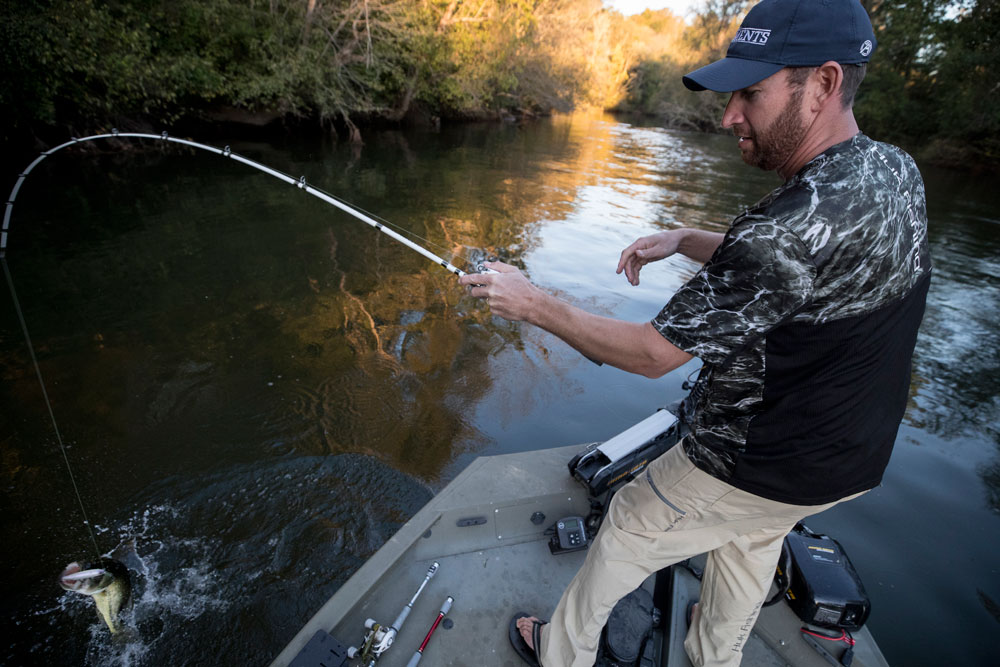
Although I was sure I only would spend a half a day fishing the north end of the lake, I ended up fishing the entire first day of practice on the north end. By 11 a.m., I only caught two bass that would score in the tournament. I decided to fish one more place, and if I didn’t catch any bass there, I planned to crank up my big engine, run back to the boat ramp and put my boat on the trailer.
At that last stop, I decided to change lures from what I’d been fishing - a crankbait and a bladed jig on little points and cuts. I switched to a swim jig and started fishing in really shallow water. I got a few bites fishing that skinny water with a swim jig. I decided to change to the swim jig due to the vast amount of shallow water. I knew I could fish the swim jig fast, come through the large amount of brush and grass and cover a lot of water without getting hung up. In the first five minutes of fishing the swim jig, I caught a bass that would weigh 4-5 pounds. Five minutes later, I caught another bass that would weigh more than 2 pounds. After I caught the second fish, I cut the hook off of my swim jig because I didn’t want to hook any more bass than I would need in the tournament. I just wanted to get more bites with that same swim jig and not hook the bass with the bait. In the next three hours of fishing the swim jig, I got between 15-20 bites.
I’m often asked, “When you cut the hook off the swim jig, does it impact the action of the jig?” The answer is, “No. It doesn’t.” The swim jig runs just as it did when the barbed hook was on it.
So, instead of leaving, I stayed in the northern half of the lake all day long and felt confident that I could catch the bass that would enable me to place well in the tournament. Confidence plays a major role in any day of fishing that you may have, so I decided that my first guess (to fish the northern end of Sam Rayburn Reservoir) was the section of the lake where I should be able to catch the most bass. The swim bait seemed to be catching those bass. When I went to bed after the first practice day, I was feeling pretty good about where I should fish, how I should fish, and what lure I should use. By doing the research that I did before the tournament and coming up with a game plan that I thought I could do well with, I learned that my first guess about where and how to fish appeared to be the best idea.
What Was DeFoe’s Game Plan to Win the Tournament Based on Two Days of Practice?
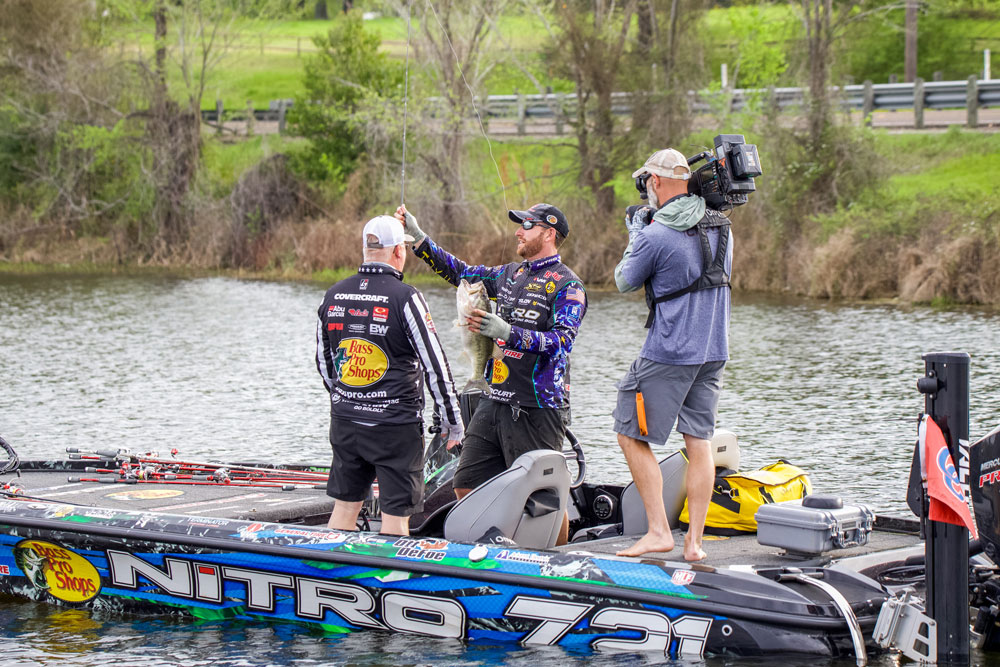
On the second day of practice, I followed my game plan to fish the southern end of the lake to see what I could catch there. Then, I could compare the results that I had from the two sections of the lake and know where I needed to fish, how I needed to fish, and what areas and lures would give me the best chance to win. I stayed in the south end of the lake all day. I caught some small bass, but I didn’t catch any big bass. I only caught one bass that would weigh 2 pounds or more.
After that second day of fishing Sam Rayburn in its southern end, I felt much more confident about fishing the northern part of the lake on the first day of the tournament. In this event, fishermen could put in on any part of the lake they wanted to fish. While I was fishing the south end of the lake, I saw many more contestants there. I thought I might be the only angler putting in at the northern end of the lake. I thought if my pattern held, and the bass did what they did on the first day of practice, I wouldn’t have any other competitors and few, if any, spectators following me where I was fishing. That night, before the third day, I was thinking about where I would start fishing on the first day of competition. I had found one little school of bass that I was able to catch with a crankbait, so I decided to start there. I knew I would catch a lot of short fish, but I also realized that every now and then off that point I occasionally could catch a 2-plus pound bass. My plan was to try to catch as many bass as I could off that one little spot with the crankbait, and then when the fish stopped biting, I’d go to the place where I had so many bites with the swim jig on the northern end.
Road to the Championship
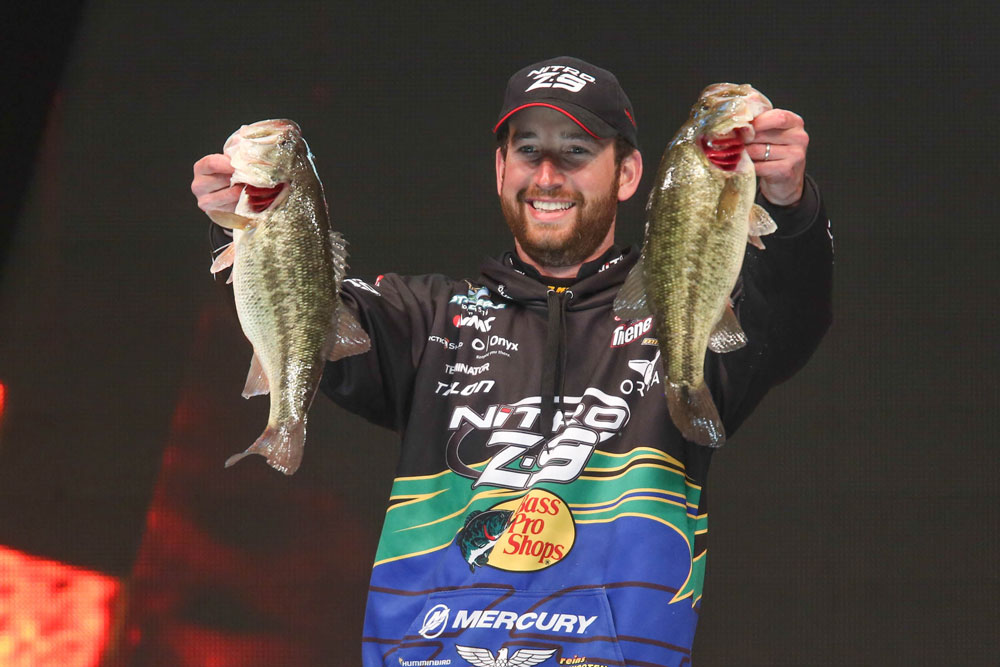
When I reached the little spot I planned to fish on the southern end of Sam Rayburn, I caught eight bass that weighed 2-plus pounds on several different lures. The crankbait, the bladed jig, the plastic worm and several other lures produced those eight, measurable bass. Before I left that spot, I had boated eight scorable fish that weighed about 20 pounds total. The bites slowed-down toward the end of the First Period, and I felt like I had milked all the scorable bass out of that spot. I knew I needed to make a change. I felt this site would replenish itself overnight, and I planned to return to that place on the second competition day and begin there. I could tell that the bass I was fishing were postspawn fish, so I thought there would be other postspawn fish that would set up there overnight. In other words, I felt like the bass told me, “Ott, you’ve worn out your welcome here; you need to go somewhere else.”
When I left my first site, I went to the northern end where I’d caught bass on the swim jig. I caught a scorable bass fairly quickly. Then I caught a few non-scorable bass, and I started going to the places where I’d had bites after I’d cut my hook off of my swim jig. I caught several more scorable bass in that section of the reservoir. The pattern I established was that there was so much flooded timber and cover that I had to get my swim jig into that really skinny (shallow) water. At times I’d cast up on the bank from zero to about 6 feet of water. The bass I caught there were spawning in about 2 feet of water, but to get them to bite, I had to get them as close as possible to the bank and retrieve my lure past the bass on the bed. I learned that if I could let that lure hit the bank and come off the bank in relatively open water, I could get a bite. I would be about 40 feet away from the bank, and the bass often would take the bait at about half that distance. I think what they were doing was seeing the bait as it moved out to deep water and following the bait out before they attacked.
I was using a 3/8-ounce Terminator and a heavy-duty swim jig in a black-and-blue color. I was tying that swim jig to 50-pound-test braided line. My rod was a Bass Pro Shop Johnny Morris Platinum 7’1” medium-heavy rod, and a Johnny Morris Platinum reel with a 8 3:1 gear ratio. When I’d make a cast, I might have to skip the swim jig into the bank or make a roll cast to get it on the bank. As soon as the jig hit the bank, I’d immediately start my retrieve. I kept my rod tip high and used a slow-to-medium retrieve to keep the jig up off the bottom and near the surface. I didn’t necessarily always have to let the lure land on the bank; however, I did have to try and get it as close as possible to the bank for the best success.
At the end of the first day, I had caught 11 scorable bass that weighed 24 pounds total and some change, and I was in 4th place and well within striking distance of the winner of the day. I wanted to do everything I could to win my round because if I did, I automatically would go into the Championship Round. I decided that I had put enough pressure on those bass with the swim jig that they weren’t going to take it as readily as they had earlier. On that first day, I only caught three scorable fish on the swim jig, and most of the bass that I had caught, I caught on those other lures early in the morning. I wanted to milk that spot as much as I could and catch as many bass as I could out of that place, and then go look for more places like that site where I’d caught so many measurable bass. The crankbait that I was using was a little crankbait that I helped design for Rapala, and I also used a Rapala DT 4.
In most tournaments, your depth finder plays a major role in where you find bass and how you catch bass. In this tournament, it did play a major role, but not how you might think. When I realized that the bass were holding in water that was 1-6 feet deep, I used the mapping feature on my Humminbird 360 to mark all of the spots on the north end of the lake where I could find that water depth. Where I was fishing was like a maze with water and cover in all directions. I looked for chutes and cuts and anywhere current was coming through an outlet or hitting a point. The major key to the pattern was finding where current was hitting an area or current was coming through a narrow area where the bass could gang up and attack the bait. All day long I didn’t see another competitor where I was fishing, and I was really surprised that no one else was there. At the end of the second day, I had won my group with 59 pounds and some change for the bass I’d caught, weighed and released. I bypassed the Knockout Rounds and went straight to the Championship Day.
How DeFoe Fished the Championship Round and Won $100,000
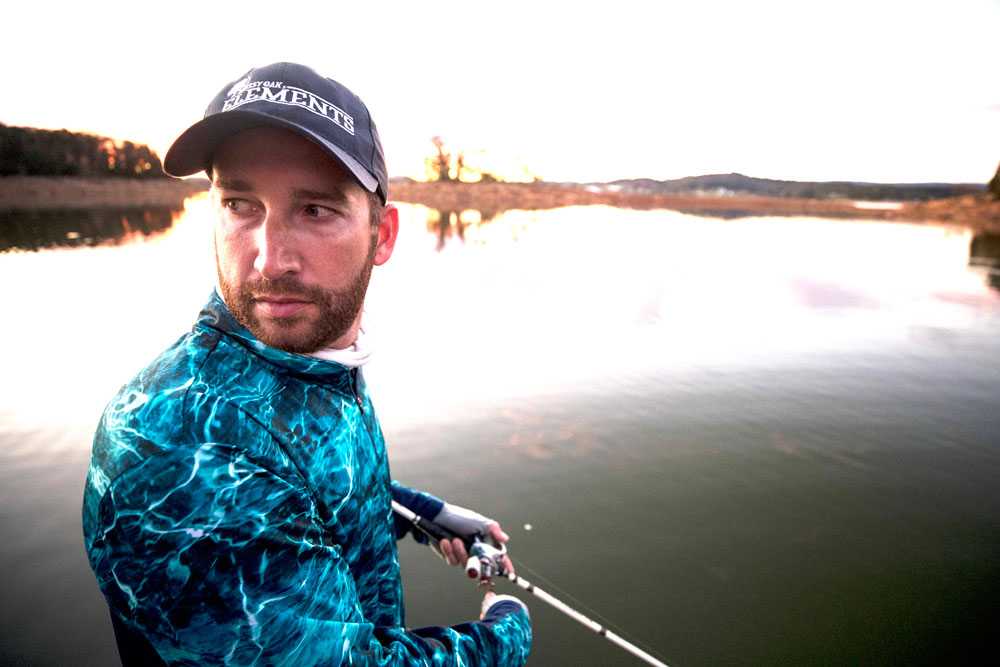
On the last day of the Sam Rayburn tournament in late March, 2021, Ott DeFoe experienced the agony of defeat and the thrill of victory all in that same day. He had a chance to win, but would he win? How would he handle the pressure? How would he make the decisions on the water that produced a $100,000 check?
By the last day of the tournament, all the other competitors pretty well knew where I was fishing. However, I wasn’t worried about any other competitor moving into my area and trying to fish the spots I’d found. On TV, the audience could look at the tournament as it unfolded. They could see where everyone was fishing, and the weight everyone was catching. However, the competitors couldn’t see what the TV audience was watching. All 10 of us were pretty well set up on where we were going to fish, and how we were going to fish.
On the first day of the tournament, I saw very few other boats, but on the last day of the tournament, there were a lot of boats out on the lake on that day. Quite a few people were out on the water fishing where I was fishing. I knew that if I had a large number of spectators following me, more than likely their boat wakes would hit the bank and spook the bass I was trying to catch. However, on that last day, I only had one fisherman following me. There were other people fishing around me who weren’t competitors but were just out fishing to have a good day. The one fellow following me stayed out of my way, didn’t get close to me and remained out of those areas he knew I was probably fishing. He was a really nice guy.
The first period of the Championship Round, I weighed in 10 scorable bass and had about 22 pounds. I was leading the tournament by about 10 pounds. I thought everything was working in my favor, and the plan I had made to go back to that little spot where I had caught so many bass before didn’t disappoint me. I’ve fished a lot of different lures at that site. I fished a 1/2-ounce chartreuse-and-white bladed jig, and then I used a Rapala DT 4 crankbait, I’d fish the squarebill prototype crankbait, a Texas-rigged worm, a spinner bait, a walking bait and finally a Bass Pro Shops Wacky Stik-O Worm. The crankbait, the bladed jig and the wacky worm consistently produced the most measurable fish in the Championship Round. The crankbait was shad-colored, the DT 4 was a penguin color with a black back and white sides, the wacky worm was a black-and-blue Bass Pro Shop Wacky Stik-0, and the 1/2-ounce bladed jig was black and blue with a Super Shad Trailer.
During the Second Period, I went to the places I’d found earlier in the tournament and didn’t get a bite. I had gone looking for the same types of spots where I’d caught all my fish, but I completely struck out throughout the entire Second Period. However, I was still leading at the end of the Second Period. Justin Lucas, who was in second place, had caught 20 pounds, so he was only 2 pounds behind me after the Second Period. I had plenty of pressure on me. I knew that during that Third Period I had to catch some bass, or Justin was going to take over the lead. I was looking the agony of defeat in the face, because I now realized how easy it would be for me to lose this tournament. I felt like I knew the kind of place I had to find to stay in the lead, and it should produce 10-15 pounds of bass during that last period. That fact helped me to stay calm in what could be a defeat. My goal was to find a spot where the current was hitting a point or coming through a gap in a water depth of 2 feet or less.
I fished hard for two hours and only caught one small bass. There were 30 minutes left in the tournament. I went back to two sites where I caught bass before, and these two spots were 100 yards apart. I decided to fish the area between those two places with my squarebill crankbait. The first bass I caught was a white bass, and the second bass I caught was also a white bass. I saw bass schooling on top, so I cast my crankbait and caught a non-scorable bass. I wasn’t leading in that last 30 minutes. Rick Clawson had 27 pounds, and I had 22. So, after I released the non-scorable bass, I caught a bass that weighed 2 pounds and 1 ounce, and several more non-scorable bass. Then the bass quit biting. I went through the rotation of lures that I had caught bass on before and didn’t get a bite. I fished away from the spot where the bass were schooling, and then I returned there and cast the bladed jig. I was 2 pounds, 12 twelve ounces behind, and the bladed jig produced a 2 pound, 12-ounce bass.
At that point, I was tied with the leader. I knew if the tournament was a tie, I should win because I’d caught more scorable bass than Rick Clawson had. I cast the bladed jig two more times and didn’t get a bite. I picked up the rod that had a Texas-rigged worm on it. I cast to the spot where the bass had been schooling, and I caught a bass that weighed 2 pounds, 13 ounces. I had 17 minutes left to fish, and I didn’t get another bite. I knew that Rick could catch a fairly good-sized bass, and he would beat me. I knew if he caught a really big bass, he would really beat me. I definitely didn’t feel like I’d won yet.
I didn’t have good cell service where I was fishing, so I couldn’t look at Score Tracker and determine whether I had won or not. I also couldn’t get the Score Tracker to update to see if Rick had caught any bass or not. Once I was able to get cell service, my Score Tracker updated, and I talked to the production crew filming the event, and I learned that I had won. I felt like the world had been lifted off my shoulders. I had fished for five hours without landing a scorable bass on the last day, but then I caught three in 30 minutes. I finally felt like I could breathe easy. When I got back to the weigh-in, the announcements were made, and I learned I had won, I was really excited because that was the third tournament I’d won in 2021. I was as surprised as anybody that I actually had won the tournament, and I just thank God for allowing me to even win.














